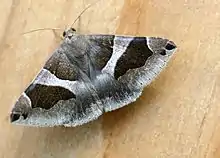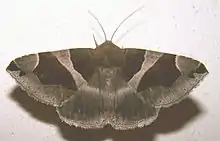Dysgonia algira
Dysgonia algira, the passenger, is a moth of the family Noctuidae. The species was first described by Carl Linnaeus in 1767 and is found in the Palearctic -the range extends from Spain and Morocco in the west to southern Europe and North Africa , Asia Minor , southern Russia to Iran , Afghanistan , Turkmenistan and Kyrgyzstan . In the north the range extends to the west of France and as far as southern Germany , eastern Austria ( Burgenland , Lower Austria ) and Hungary . In the Southern Alps it is found up to 700 meters.
| Dysgonia algira | |
|---|---|
 | |
 | |
| Scientific classification | |
| Kingdom: | |
| Phylum: | |
| Class: | |
| Order: | |
| Family: | |
| Genus: | |
| Species: | D. algira |
| Binomial name | |
| Dysgonia algira (Linnaeus, 1767) | |
| Synonyms | |
|
List
| |
Technical description and variation
O. algira L. (= achatina Sulz., triangularis Hbn) Forewing brownish fuscous, with a purplish tinge when fresh; a whitish median band narrowed in middle, edged inwardly by the erect but slightly outcurved inner line, outwardly by the similarly incurved median line: outer line acutely angled outwards on vein 6 and bluntly bent between veins 3 and 4. then sinuous to inner margin near median line; a black apical streak of two spots; the terminal area violet grey: hindwing fuscous, with a diffuse whitish median band: the terminal area grey at middle: fringe grey, below apex whitish; the ab. mandschuriana Stgr.[ now full species Dysgonia mandschuriana (Staudinger, 1892) ] is more uniformly purplish or slaty grey, with the median band only slightly paler, not white. Larva yellowish grey, darker on dorsum, with tine black longitudinal lines; venter and feet pale grey; spiracles black; head yellowish grey.[1] The wingspan is 40–46 mm.
Biology
The moth flies from May to August depending on the location. The larvae feed on Rubus and willow.
References
- Warren. W. in Seitz, A. Ed., 1914 Die Großschmetterlinge der Erde, Verlag Alfred Kernen, Stuttgart Band 3: Abt. 1, Die Großschmetterlinge des palaearktischen Faunengebietes, Die palaearktischen eulenartigen Nachtfalter, 1914
 This article incorporates text from this source, which is in the public domain.
This article incorporates text from this source, which is in the public domain.
External links
 Media related to Dysgonia algira at Wikimedia Commons
Media related to Dysgonia algira at Wikimedia Commons- Passenger on UKMoths
- Lepiforum e.V.